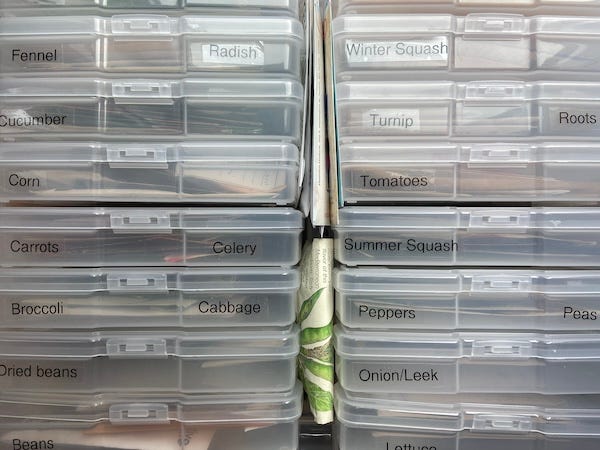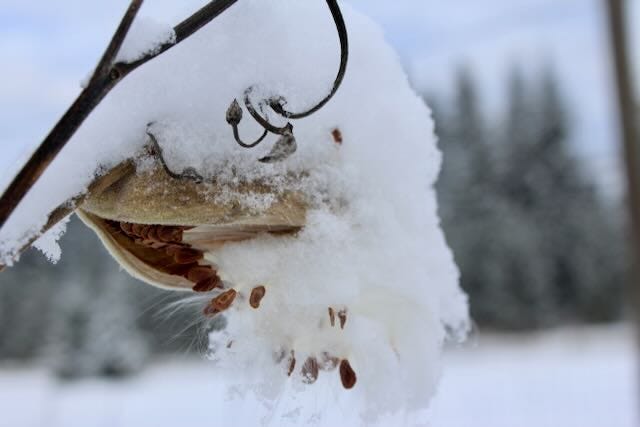There is a foot of snow on the ground, and March often brings a final dump of mountain snow, but my seed bins are out for inventory and garden planning. There’s a subtle excitement building in my head as I dreamily engage in the seasonal imaginings of my garden in its full abundance.
My winter daydreams of my garden are always perfect: plants adorned with fruit in all stages, new buds developing, pollinators flitting in and out of opened flowers, mulch suppressing weeds, sun shining, and the temperature is just right. The longing and expectations always replace the memories of past less-than-ideal gardens.
My memories and imagination conveniently forget the cold, drizzly spring rain, the occasional snow flurries and even hail in April; the late frost after transplanting seedlings; the leaf-sucking aphids, lettuce-eating rabbits, and thieving pocket gophers; weeks of extreme heat and drought; the bone-tired exhaustion of harvest, processing, and preservation work; the early frost that killed the basil I was going to pick the next day; and the aches of a 65-year-old body whose brain thinks it is still 35.
Despite the challenges, growing plants is part of who I am and how I live. It feeds both my body and my soul. Growing plants is not on the list of possible changes as I age. Leaving a garden that I have nurtured for fifteen years is something I am not quite ready to do. (See A Place Called Home)
The seasons of gardening are much like the seasons of a romantic relationship:
Winter is a time of expectations, longing, romantic daydreaming, and hopeful longing.
Spring is the season of lustful giddiness, the excitement of emerging new growth and bursts of energy, obsessive contemplation, long days of illumination, and the complete embrace of hope.
Summer is about developing familiarity, the comfortable rhythms of a daily relationship, and nurturing stability and wellness. Summer is also the first disappointment (a plant dies, aphids infect all of the kale plants, critters enjoy your harvest before you do), the first time the relationship is tested, the reality that effort and respect are the only ways to sustain the relationship and while hope is always present, it’s a bit tarnished on the edges.
Late summer focuses on the exhaustion of physical work, the questioning of its value in my life, and moments of frustration and exasperation alternating with satisfaction, contentment, and pride.
Autumn is the reckoning and the reaping, the acknowledgment that the garden and I have been successful in another year of our shared goal of growing. Admiration for our commitment and my appreciation settle into place with the protective winter blanket of mulch. Hope is polished a bit in anticipation of the next season.
Hope is what sustains my annual romance with growing food. In her book Hope In the Dark, Rebecca Solnit declares that “to hope is to give yourself to the future.” Planning a food garden in the middle of a February snowstorm is a remarkable act of hope and faith. Part of my hope is rooted in my belief that growing some of my food matters, not only in the rewards of a vegetable abundance but on a larger scale of a daily commitment to caring for something beyond myself and reducing my environmental footprint. Hope is imbued in continuing this ancient relationship with nature, the exchange of needs being met, and the calculation of gains and losses. A quote from Robin Wall Kimmerer’s book, Braiding Sweetgrass, falls out of my garden planner, a reminder that hope is an act of shared love, a belief in the possibility of sacredness:
“Knowing that you love the earth changes you, activates you to defend, protect, and celebrate. But when you feel that the earth loves you in return, that feeling transforms the relationship from a one-way street into a sacred bond.”
Wellness
The benefits of tending gardens have dramatically altered the second half of my life. Abandoning the conventional life and taking up the riskier and unprogrammed version by committing to a simpler lifestyle has greatly improved my emotional, physical, and mental wellness. In the clinical world, research indicates that horticultural therapy can improve the lives of older people in the following ways: “reduction of pain, improvement in attention, lessening of stress, modulation of agitation, lowering of as-needed medications, antipsychotics, and reduction of falls.”1
Growing vegetables and medicinal herbs offers the following benefits for me:
Access to nutrient-dense, organic, and diverse food
A home apothecary of herbal teas & remedies
Increased knowledge and awareness of a healthy lifestyle
Connection to other species that share the land I live on
Time & place to think, grieve, and celebrate
Daily movement of my body
Time outdoors in nature and sunshine generating Vitamin D
Reduced stress & blood pressure
Mentally, I experience profound sensory engagement when I am in the garden. Like many in the 21st century, I spend too much time in front of a screen. As we age, we experience a decline in sensory functions, which can impact our quality of life, health, and independence.2 In the quiet of the garden, each of my senses is engaged. On an early summer morning, I hear birdsong, witness the sun’s pinkish sunrise, smell the sweet aroma of blooming milkweed, feel the gritty dirt for moisture, and taste a ripened strawberry - all in the first five minutes.
Learning and problem-solving are activities that keep our neural networks humming. Word games are suggested, but researchers say learning something new is one of the best ways to keep our brains healthy. Some older people tend to drop active and intentional learning as they age. Growing plants is filled with lessons to be learned, research to be done, and problems to be solved.
Creativity is inspired, and I often think of my garden as an artist’s blank canvas and the flowers, vegetables, and herbs as my palette of colors, textures, and shapes.
Emotionally, I feel a camaraderie with my garden and our shared plants. I witness the relationships between pollinators and flowers, inspiring a moment of wonder. I am curious about earthworms digging deeper into the soil to escape my garden spade. My sense of pride increases as I harvest what I have nurtured for months (and shamelessly point out what came from my garden at each meal). My experience as a grower has made me more compassionate and empathetic; watching nature’s ability to survive and thrive models an essential kind of wisdom. Of course, there are also bouts of disappointment, anger (looking at you, gophers), and frustration. My time and effort in the garden make me happier and more content.
Growing plants is a remarkable opportunity to appreciate nature and its complexities fully. Witnessing a plant’s life cycle is a humbling and sacred experience: seeds germinate, stems push up through the soil, leaves unfurl, flower buds open into flowers, flowers become fruits, and fruits dry out to release seeds for the next generation. A garden can be a place of awe and wonder if we are paying attention.
The science of biology has acknowledged that our brains are wired for connection with nature, and studies have shown that time spent in nature benefits our brains and stress levels. In an egocentric culture like ours, my focus shifts each morning to the garden ecosystem that is alive with the activity of others.
Resilience
As I age, resilience - the capacity to withstand or recover from difficulties - has become essential to my independence. Our culture has outsourced most of our daily needs: we are at the mercy of corporations for our food, clothing, healthcare, childcare, and even eldercare. Growing food and medicine is my equivalent of giving the middle finger to a culture that has separated us from the natural world. As the price of food increased over the last two years, I developed a mild case of smugness: I wasn’t paying premium prices for week-old, decaying produce.
As the effects of climate change continue, resilience will force individuals and communities to make changes to their access to healthy food. A recent ice storm closed the interstate for several days, and our local grocery shelves emptied quickly. Developing a local food economy is key to building resilient communities. Growing some portion of your food is part of the effort.
All of this begins with seeds.
PS: I finished and edited this essay while recovering from a nasty virus that made my head feel like it was going to explode. It feels like I made sense, but if not…I am blaming the virus.
Thank you for being here. All of my posts are free, but if you’d like to support my work, you can do so by:
Liking and restacking this post so others are encouraged to read it.
Share this post via email or on social media.
Taking out a paid subscription to this Substack.
I would love to hear about your garden planning and thoughts about aging and gardening. Please share your thoughts and ideas in the comments.
https://www.ncbi.nlm.nih.gov/pmc/articles/PMC3372556/
https://www.ncbi.nlm.nih.gov/pmc/articles/PMC7998691/











What a beautiful and profound meditation on edible gardens as a way to reorient our lives and subvert the dominant culture! Thank you for the reminders of the rhythms of the garden seasons, and the myriad health and wellness benefits of gardening--especially as we age. I am two years older than you, so my cultivated gardens have shrunk to a size I can continue to manage and have gone into stock tanks perched on concrete blocks to be raised above the ground and easier to tend with an aging and very achy body.
I hope the flu has left you, and that you're feeling more yourself again!
I so appreciate your gardening thoughts and experience as well as the pics! Lots to munch on here! May your flu soon be history and letting you alone for a good long time. Do rest as you can.